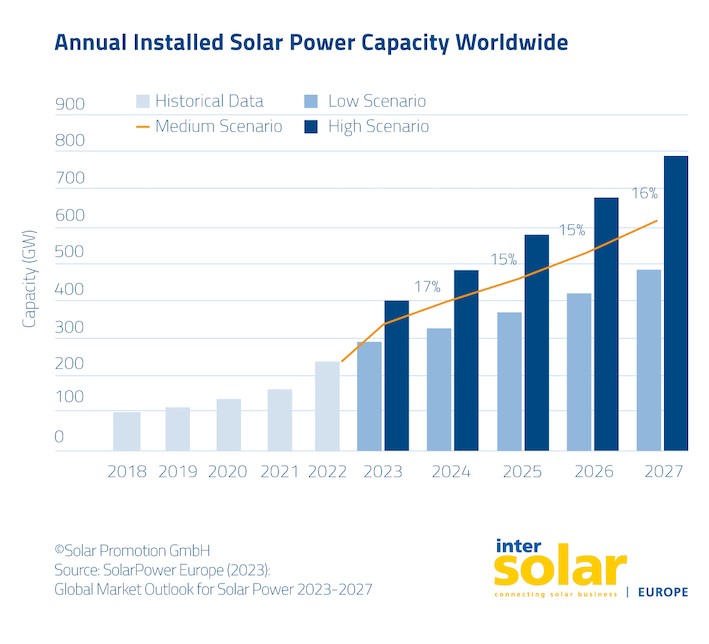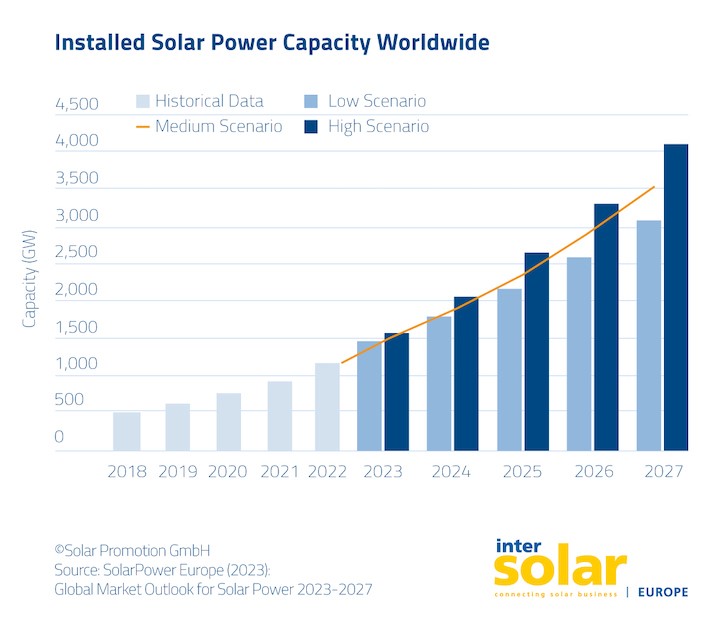GERMANY. Currently, photovoltaics represents two thirds of all electricity generation capacity from renewable sources installed last year.
At the conference “Global Perspectives of the Solar Energy Market 2023-2027”, presented by Solar Power Europe, the European association of companies in the sector, it was confirmed that the photovoltaic market reached record numbers, with growth of 239 GW.

TW era (terawatts)
In 2022, accumulated capacity surpassed the 1 TW mark for the first time, but market growth predicts an expectation of reaching the 2 TW mark by 2025 and, by 2027, reaching a total of 3 TW.
Some factors are responsible for the acceleration of the photovoltaic sector, such as the increased demand by an independent energy supply with renewable sources, flexibility and the ability to carry out projects at low costs.
Photovoltaic market growth leaders
Some countries stood out in terms of installed capacity, among them, China is at the top with a power of 95 GW and an annual growth of 72%. Then the USA (21.9 GW), India (17.4 GW) and Brazil (10.9 GW). With regard to Europe, Spain (8.4 GW), Germany (7.4 GW), Poland (4.5 GW) and the Netherlands (4.1 GW) are on the list of countries with the largest installed capacity.
On a global scenario, the European market continues to lead in terms of number of installations per capita. With positive forecasts for the solar sector, Europe has been working to expand the sector through policies to improve energy security, establishing new regulations that boost decentralized and digital renewable energy in Europe.

Technologies and trends
Hybrid models of technology use have driven the market. An example of this is the use of photovoltaic in combination with the energy storage and the electric mobility. The use of solar and wind installations they can also provide indispensable network stabilization services.
The drop in prices for photovoltaic installations has also been a major factor in the sector's growth. According to a recent study by Fraunhofer Institute for solar energy systems, between the years of 2010 and 2020, you photovoltaic module prices fell 90%. Currently, standard modules with polycrystalline and monocrystalline cells have an average price of 0.26 euros per watt-peak.
With lower costs, photovoltaic projects have become increasingly accessible and have enabled more modern installations. Agrivoltaics is an example that has been growing and meeting the needs of the agricultural sector through solar energy. With the growth of this sector, Italy has sought to promote incentives for agrivoltaic installations.
Another model that has gained ground based on photovoltaics is floating, with its high efficiency thanks to the cooling effect of water evaporation, especially used and recommended for regions where soil is scarce and water is more abundant.
















